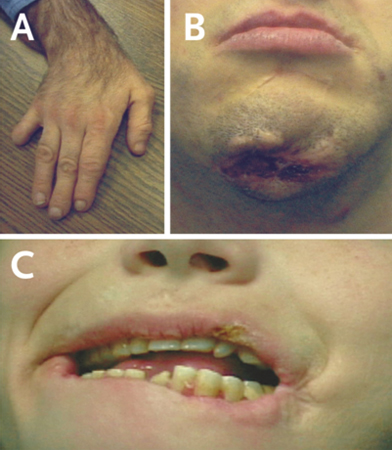Differentials
Cerebral palsy
SIGNS / SYMPTOMS
Owing to the occurrence of hypotonia and developmental delay early in the course of the disease, many patients are diagnosed as having cerebral palsy until the tell-tale features of Lesch-Nyhan disease (LND), such as self-injury or overproduction of uric acid, are recognised.
INVESTIGATIONS
Hyperuricaemia is not typical in cerebral palsy.
Hypoxanthine-guanine phosphoribosyltransferase (HPRT) gene analysis and HPRT enzyme activity will provide definite diagnosis in cases of LND.
Diseases with developmental delay
SIGNS / SYMPTOMS
The differential diagnosis for developmental delay is extensive.[36]
Lesch-Nyhan disease (LND) should be suspected if delayed development is accompanied by self-injurious behaviour or evidence of excessive production of uric acid.
INVESTIGATIONS
Hyperuricaemia is not typical in these conditions.
Hypoxanthine-guanine phosphoribosyltransferase (HPRT) gene analysis and HPRT enzyme activity will provide definite diagnosis in cases of LND.
Diseases with dystonia at young age
SIGNS / SYMPTOMS
The differential diagnosis for dystonia at young age is extensive.[37]
Lesch-Nyhan disease (LND) should be suspected if dystonia is accompanied by self-injurious behaviour or evidence of excessive production of uric acid.
INVESTIGATIONS
Hyperuricaemia is not typical in these conditions.
Hypoxanthine-guanine phosphoribosyltransferase (HPRT) gene analysis and HPRT enzyme activity will provide definite diagnosis in cases of LND.
Other diseases with self-injury (e.g., intellectual disability, autism, Prader-Willi syndrome, fragile X syndrome)
SIGNS / SYMPTOMS
Self-injury in Lesch-Nyhan disease (LND) is usually more severe than in other conditions, and the prominent topographical preference for mouth and fingers is not frequently seen in other conditions.[38]
Self-injurious behaviour in LND is always accompanied by profound motor impairment. LND should be suspected when self-injurious behaviour is associated with the typical motor dysfunction emerging early in life, especially if there is also hyperuricaemia.[Figure caption and citation for the preceding image starts]: Examples of self-injurious behaviour seen in patients with classic Lesch-Nyhan diseaseFrom the collection of H.A. Jinnah, MD, PhD; used with permission [Citation ends].
INVESTIGATIONS
Hyperuricaemia is not typical in these conditions.
Hypoxanthine-guanine phosphoribosyltransferase (HPRT) gene analysis and HPRT enzyme activity will provide definite diagnosis in cases of LND.
Use of this content is subject to our disclaimer